#tetrao urogallus
Explore tagged Tumblr posts
Text



Photo source 1
Photo source 2
Map source
#poll#birds#western capercaillie#galliformes#phasianidae#tetrao#tetrao urogallus#eurasia#asia#europe
45 notes
·
View notes
Text

Capercaillie / Urogallo / Tetrao urogallus /. Finland.
By David Vilas Prat
#david vilas prat#photographer#flickr#capercaillie#bird photography#urogallo#tetrao urogallus#nature#winter#snow#finland
48 notes
·
View notes
Text

Western Capercaillie
13 notes
·
View notes
Text
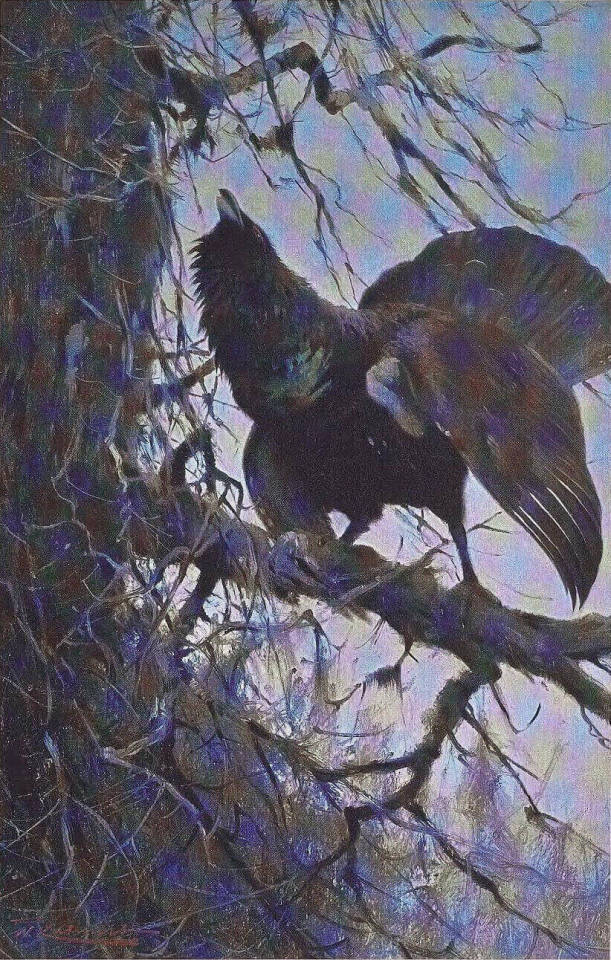
Capercaillie (Tetrao urogallus) | Animal portraiture (1912) | Biodiversity Heritage Library | Flickr | Public domain
7 notes
·
View notes
Text
Critter fact #92:
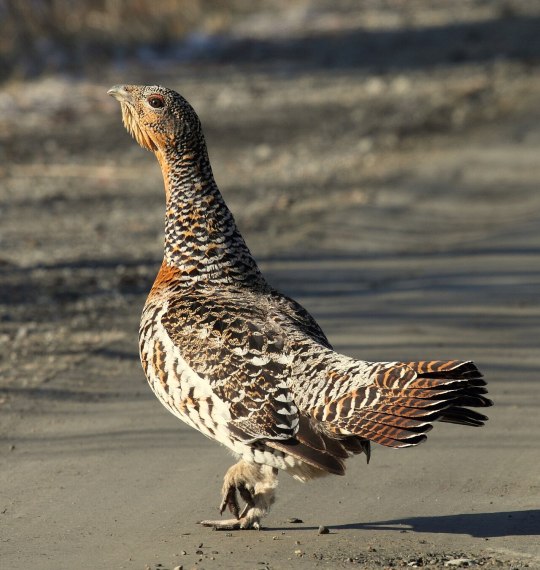

Daily critter fact #90: The capercaillie (Tetrao urogallus), a European game bird, is the largest member of the grouse family.
13 notes
·
View notes
Text

Western Capercaillie (Tetrao urogallus) - Zoo Santillana del Mar, Cantabria, Spain
3 notes
·
View notes
Text
Capercaillie my beloved <3
14K notes
·
View notes
Text
UROGALLO COMÚN
TETRAO UROGALLUS NOMBRE CIENTÍFICO: TETRAO UROGALLUS LONGITUD: 80 A 115 CM. PESO: 4 A 4,5 KILOS. PLUMAJE: DIFERENTE SEGÚN EL SEXO. MIGRACIÓN: NO MIGRATORIO. ESTADO: MENOR RIESGO. UBICACIÓN: NORTE, OESTE Y SUR DE EUROPA, OESTE A CENTRO DE ASIA. ESTE UROGALLO DE CUERPO FUERTE QUE VIVE DENTRO Y EN LAS MÁRGENES DE BOSQUES, DEPENDE CASI POR COMPLETO DE LAS PIÑAS DE PINO PARA OBTENER SU ALIMENTO DE…

View On WordPress
0 notes
Text
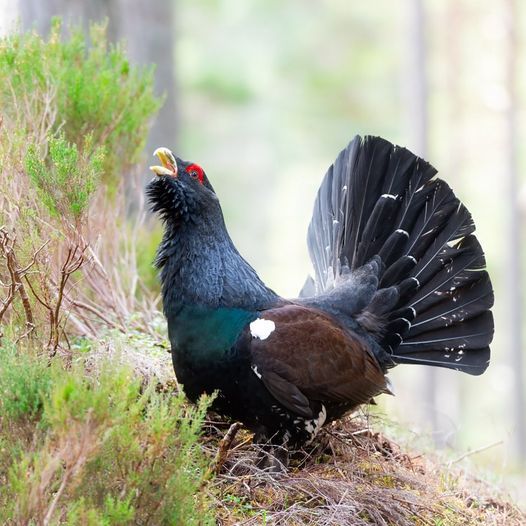
Western Capercaillie aka Cock-of-the-Woods aka Woodgrouse (Tetrao urogallus), male displaying, family Phasianidae, order Galliformes, Scotland
photograph by Paul Cameron Images
458 notes
·
View notes
Text
Disney Villains as Birds
This idea just came in mind combining two fields I’m interested. Not just looking for the color but appearance, feeling and behavior also matters.
Very personal opinion you may disagree but friendly discussion welcomed :)
HERE WE GO!
Hans: Blue-breasted Fairywren (Malleus pulcherrimus)
Very cute and pretty-looking bird! Known for their unique courtship of delivering petals.
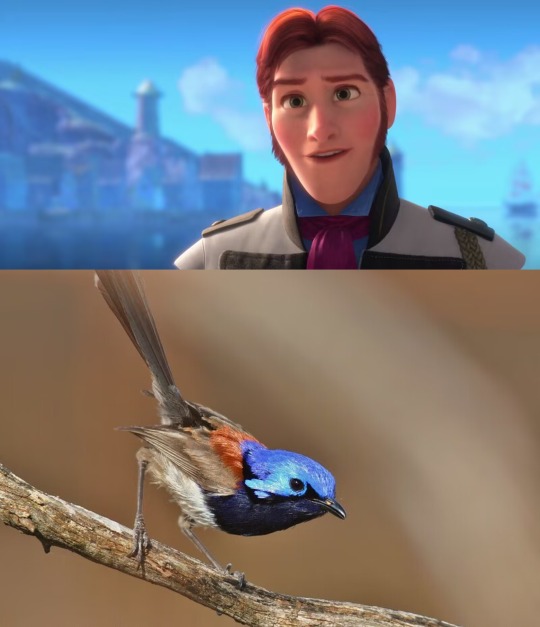
©Disney
©Laurie Boyle
Judge Claude Frollo: Demoiselle Crane (Grus virgo)
#That Hair

©Disney
©salis-
Hades: Steller’s Jay (Cyanocitta stelleri)
HE HAS TO BE A CORVIDAE. And just look at that hairstyle and that…eyebrows?

©Disney
©Daniel Plumer
Queen of Hearts: Papyrus Gonolek (Laniarius mufumbiri)
Fun fact: Like shrikes, they impale their prey on thorns.
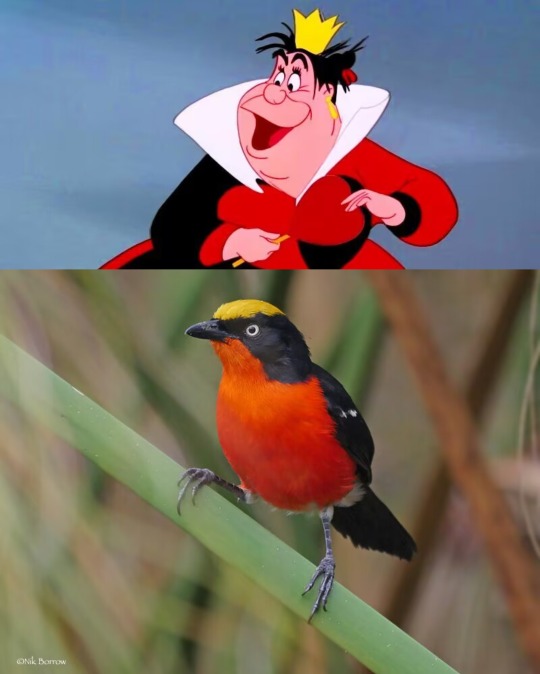
©Disney
©Nik Borrow
Queen Grimhilde: Black-shouldered Kite (Elanus axillaris)
Fairest bird of all

©Disney
©I Am birdsaspoetry.com
Jafar: Bearded Vulture (Gypaetus barbatus)
One of my fav. Now Iago has someone his same class.

©Disney
©pilot_micha
Yzma: Lesser Florican (Sypheotides indicus)
#THAT EYELASH
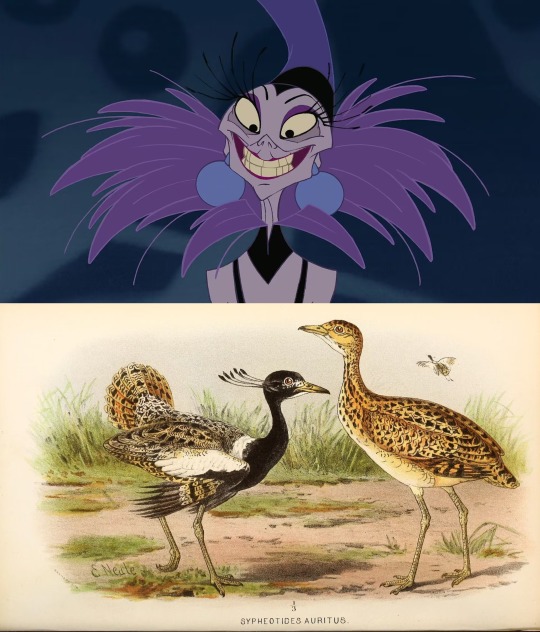
©Disney
There’s no copyright restriction on the other pic from website so I guess I’m good.
Cruella De Vil: Houbara Bustard (Chlamydotis undulata)
She would see the bird as her greatest accessory.

©Disney
©Frank Vassen
Dr. Facilier: Long-tailed Glossy Starling (Lamprotornis caudatus)
The metallic effect of their plumage just matches Facilier’s shadow power and colorful effects made by his friends on the other side.
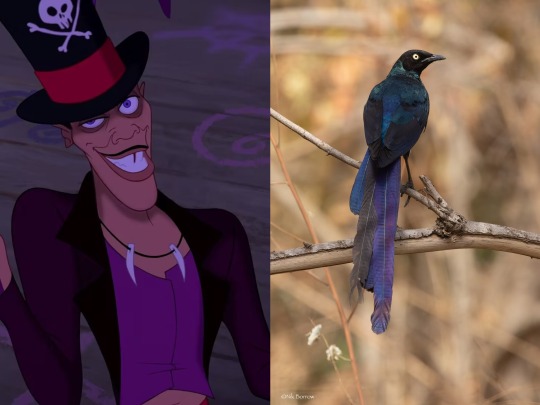
©Disney
©Nik Borrow
Mother Gothel: Long-tailed Paradise Whydah (Vidua paradisaea)
Known to be brood parasites like cuckoos.
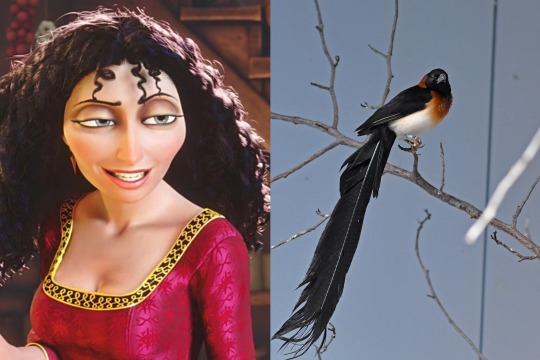
©Disney
©Brian Henderson
Gaston: Western Capercaillie (Tetrao urogallus)
No one makes that mating call like Gaston!
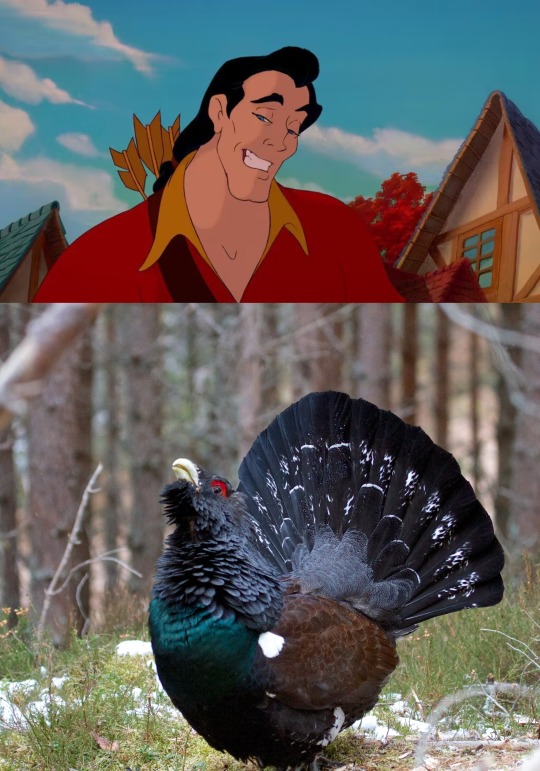
©Disney
©sighmanb
Ursula: Peruvian Pelican (Pelecanus thagus)
Those who couldn’t pay their price were devoured, FOR SURE

©Disney
©Rogerio Camboim S A
Maleficent: Common Raven (Corvus corax)
Need I say more?
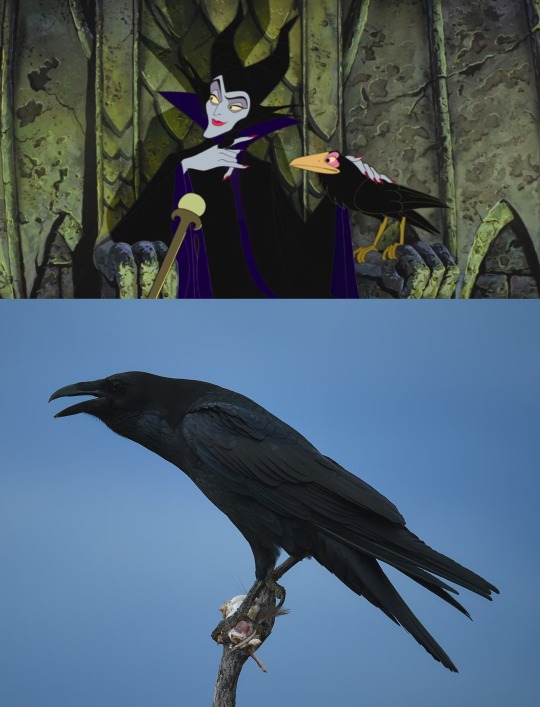
©Disney
©Henry
Captain Hook: Magnificent Frigatebird (Fregata magnificens)
Obviously

©Disney
©Andy Morffew
Lady Tremaine: Ruff (Calidris pugnax)
Her daughters would LOVE this outfit
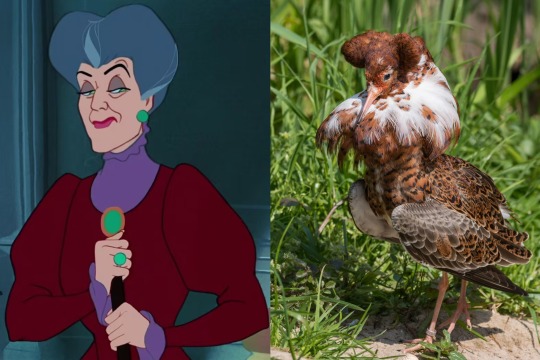
©Disney
©Mibby23
THANKS SO MUCH FOR READING!
BONUS: Kuzco
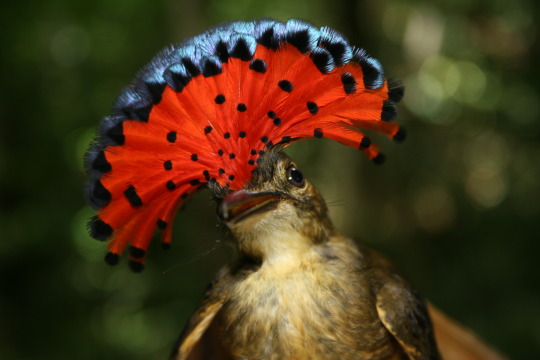
©Richard Gibbons
#disney villains#birds#prince hans#judge frollo#hades#queen of hearts#evil queen#jafar#yzma#cruella de vil#dr. facilier#mother gothel#gaston#ursula#maleficent#captain hook#lady tremaine#did tons of research on this#So tired omg going to bed#emperor kuzco#kuzco#Bro got turned into a bird this time
388 notes
·
View notes
Text


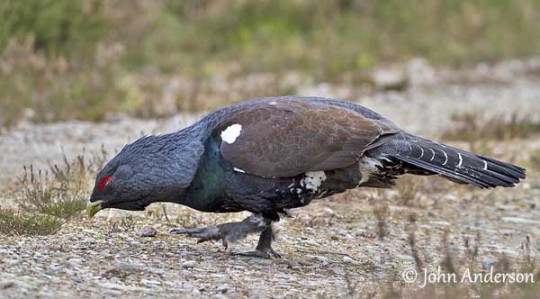
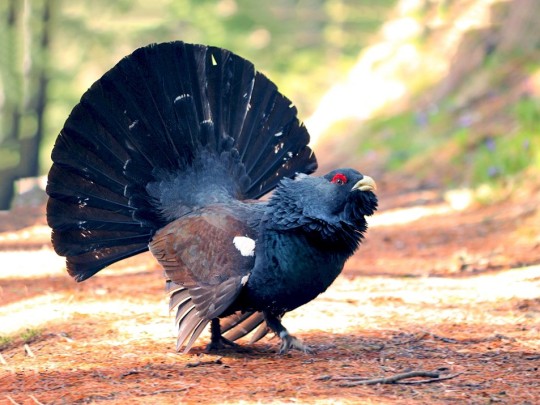

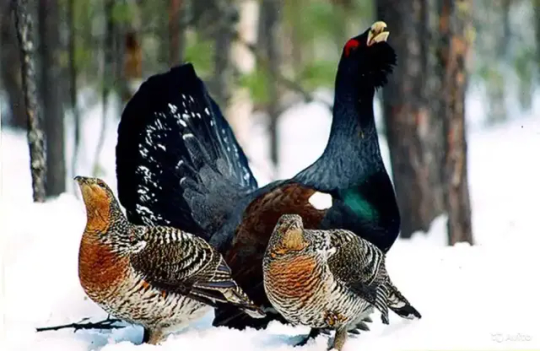
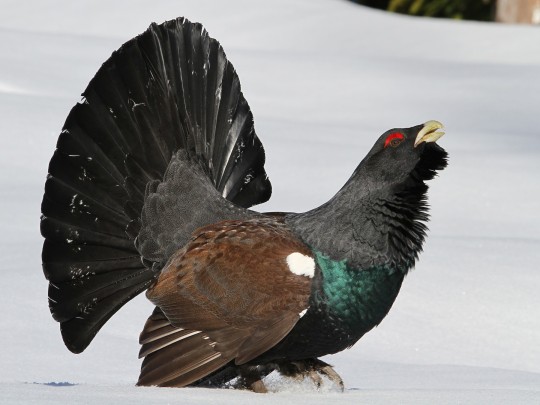
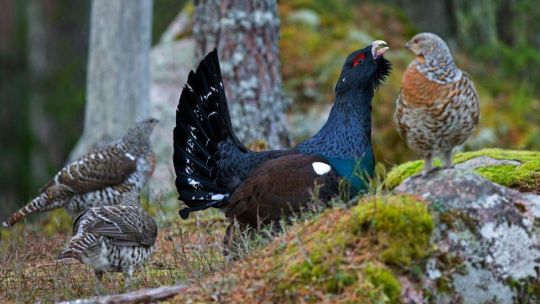
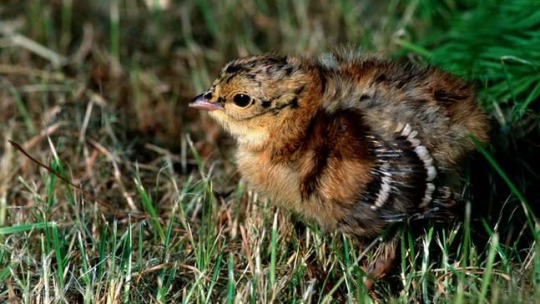
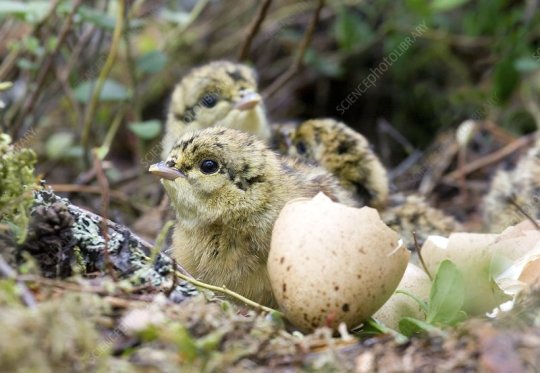
The western capercaillie (Tetrao urogallus), also known as the Eurasian capercaillie, wood grouse, heather cock, cock-of-the-woods, or simply capercaillie is a species in the grouse family which is endemic to the taiga and boreal forest of Northern Eurasia, from Scotland in the west to Russia in the east. They are typically diurnal ground dwelling birds which while capable of flight, are fairly clumsy in the air due to there short rounded wings. While taking off they produce a sudden thundering noise that deters predators. At night they rest in the horizontal branches of tree stands or within thick ground cover such as bushes and sedges, emerging during the day to feed upon seeds, buds, leaves, berries, insects, grasses, and conifer needles. Capercaillies are themselves eaten by wolves, lynx, foxes, eagles, martens, bears, boar, goshawks, and owls. With females reaching around 21- 25 inches (54- 64 cms) long & 3.5 to 5.8lbs (1.5 to 2.5kg) in weight while the male can reach 29 to 40 inches (74 -100cms) long and 9lbs to upwards of 15lbs (4 to 7kg) in weight, the western capercaillie is one of the most size sexually dimorphic living bird species, only exceeded by the larger types of bustards and a select few members of the pheasant family. The females upper parts are brown with black and silver barring; on the underside they are more light and buffish yellow. While the males are dark grey to dark brown, with the breast feathers being dark metallic green. The belly and undertail coverts vary from black to white. Both sexes have a white spot on the wing bow. They have feathered legs, and their toe rows of small, elongated horn tacks provide a snowshoe effect enabling them to traverse thick snow with ease. The breeding season begins in March or April and lasts until May or June. Three-quarters of this long courting season is mere territorial competition between neighboring cocks or cocks on the same courting ground. Towards the end of the courting season the hens arrive on the courting grounds, at which time the dominate cock or cocks flies to an open space nearby and continuously displays. If impressed one or more hens will approach and be mounted. Females will lay 3 to 12 eggs over a 10 day period, which she will incubate for 26 -28 days until hatching. The young will remain with there mother for around 3 months, Under ideal conditions a western capercaillie may live upwards of 18 years.
#pleistocene#pleistocene pride#pliestocene pride#pliestocene#cenozoic#capercaillie#western capercaillie#wood grouse#eurasian capercaillie#bird#birds
42 notes
·
View notes
Photo

Western Capercaillie
53 notes
·
View notes
Text

Auerhahn | Die Vögel (1913) | Alfred Edmund Brehm (1829-1884) | Biodiversity Heritage Library
#alfred edmund brehm#illustration#ornithologie#auerhahn#tetrao urogallus#phasianidae#vögel#vogelporträt
2 notes
·
View notes
Photo
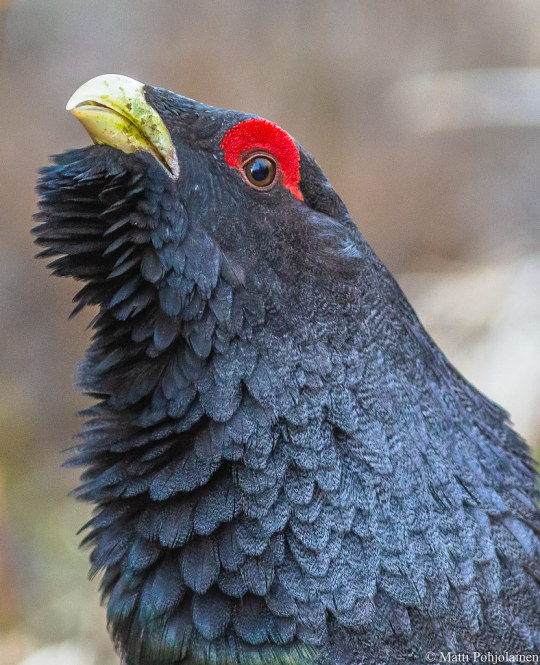
Metso (Tetrao urogallus) ♂, Western capercaillie by pohjoma https://flic.kr/p/2ooUDm6
6 notes
·
View notes
Note
Hello dear resident bird-knower, have you seen this video? https://www.tumblr.com/miadoesntwantyoutofollowher/644839758213840896?source=share
I would love to know what the fuck? how the fuck? where the fuck can I find more? Thanks. We haven't spoken before, but looking at your posts, I figured you'd be the most likely to know :)
omg first of all Thank You for coming to me with this I had not seen this video before !! and secondly, this magnificent beast is a Western Capercaillie ! which I really like because they're really cool and most importantly close relatives to one of my favorite birds of all time the ptarmigan <3
here's what animalia.bio has to say about them :
"The western capercaillie (Tetrao urogallus ), also known as the Eurasian capercaillie, wood grouse, heather cock, cock-of-the-woods, or simply capercaillie, is a heavy member of the grouse family and the largest of all extant grouse species. The heaviest-known specimen, recorded in captivity, had a weight of 7.2 kilograms (16 pounds). Found across Europe and the Palearctic, this primarily-ground-dwelling forest grouse is renowned for its courtship display. This bird shows extreme sexual dimorphism, with males nearly twice the size of females. The global population is listed as "least concern" under the IUCN, although the populations of central Europe are declining and fragmented, or possibly extirpated."
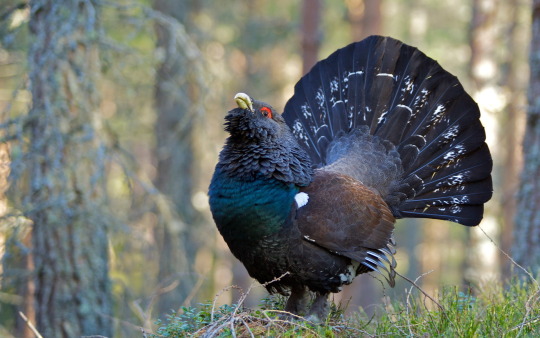
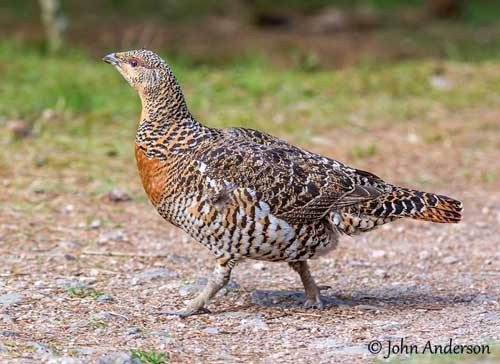
#tres-wack#that's a big boi !#birds#sorry im publishing this I hope that's not an issue#I don't do it usually but I wanna share the birds#western capercaillie#asks#grand tétras
4 notes
·
View notes
Text

Heute möchten wir mit Euch über Auerhuhn und Auerhahn sprechen, die ebenfalls Opfer des Artensterbens sind. So werden diese beeindruckenden Vögel in der roten Liste für DE bereits als "vom Aussterben bedroht" geführt! 😰
Wikipedia dazu: "Das Auerhuhn (Tetrao urogallus) ist eine Vogelart aus der Familie der Fasanenartigen (Phasianidae) und der Ordnung der Hühnervögel (Galliformes). Es ist zugleich der größte Hühnervogel Europas. Es besiedelt Nadel-, Misch- und Laubwaldzonen von Schottland über Nordeuropa bis in den Osten Zentralsibiriens. In Europa besiedelt es heute boreale und gemäßigte Zonen oberhalb von 1000 Metern über dem Meeresspiegel.
Sein ursprünglicher Lebensraum umfasst in erster Linie die Taiga Nord- und Osteuropas, daneben auch die ursprüngliche Nadelwaldzone der Alpen und Mittelgebirge. Große und geschlossene Vorkommen des Auerhuhns finden sich noch in den borealen Nadelwäldern Europas, wo die Art zwar großteils rückläufig ist, aber laut IUCN noch bei 1,5 bis 2 Millionen Tieren liegt.
Als wesentliche Ursachen des Rückgangs werden Einflüsse aus der modernen Forstwirtschaft angegeben. Obwohl die Jagd auf Auerhühner in allen Ländern reguliert oder verboten ist, werden insbesondere in Teilen von Süd- und Osteuropa erhebliche Verluste durch Wilderei angenommen."
Diese Annahme können wir bestätigen, da "Jagdreisen" (siehe Quellen) diverse Ratschläge gibt, wie und wo man Auerhähne legal jagen kann - sogar Österreich wird hier erwähnt! ☹️
Fazit: Nachdem es in DE kaum noch Auerhühner gibt, weil wir ihren Lebensraum zerstört oder sie erschossen haben, weichen einige Jäger auf Russland, Belarus oder Rumänien aus, wo es aktuell noch mehrere Populationen gibt - fragt sich nur, wie lange noch... 😰
Quellen: ➡ LINK 1 ➡ LINK 2 ➡ LINK 3 ➡ LINK 4 ➡ LINK 5
0 notes